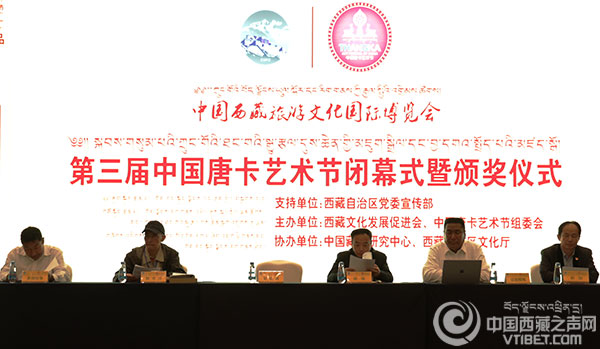Thangka art from Tibetan herders of Qinghai become a hot seller

Wrapping the canvas, sketching with charcoal, drawing, and adding colors… The students are busy creating art with the guidance of their teachers at the Regong Art Academy in Tongren County of Huangnan Tibetan Autonomous Prefecture, Qinghai Province.
The Regong Art Academy was founded in 2006. Located in Wutun Village, Longwu Town, in Tongren County of Qinghai Province, the academy specializes in China’s intangible cultural heritage as well as the research, training, creation, and sales of fine art in Regong.
There are 180 national-level artisans and experts at the academy producing over six thousand works of Thangka art annually. There are also 632 pieces of antique Thangka art from the Ming Dynasty and Qing Dynasty, and artwork from national-level master artists on-site.
Tongren County is an impoverished region in Qinghai. To reduce poverty for the Tibetan residents of Qinghai, Tongren County is trying to use Regong art as a poverty-reduction enterprise and to help local herders overcome poverty via this unique channel.
According to Tashi Dangzhou, the manager of the Regong Art Tradition Institute, ever since November of 2010, the academy has organized almost one hundred impoverished herders from the six Tibetan prefectures in Qinghai to participate in five years of free Thangka art training, so as to give the local herders a valuable skill, increase their income, and to help promote and pass on the art of Regong Thangka art.
Jiuxie, a 22-year-old student, has already lived at the academy for seven years. He was a struggling herder from Nengke Township in Jainca County of Qinghai Province. He recalled, “Seven years ago, my family was really poor. We made only about two thousand yuan every year, and barely lived with the income from a few cows and sheep. When the Regong Art Academy was calling for students from impoverished backgrounds, my foster parents decided to send me here to learn Thangka art. I could learn something useful and make money for the family with my work. I’m so grateful to the school for the opportunity.” Said Jiuxie, who has already become a teacher of Thangka art. “In 2014, after finishing five years of school, I decided to stay to teach, and hopefully pass on this skill to more poor kids in the Tibetan area.”
"Drawing Thangka not only calms me down, when I become good at it, I could get rich from it too. Drawing Thangka is hard work though, you have to sit the whole day and your legs would get numb.” Teachers from the art academy now make over 100 thousand yuan a year. Huayang, a student at the academy, said as he created a work of art. “That is my goal too. I want to earn a high salary in the future, and help continue the tradition of Regong art.”
Tashi Dangzhou said, “Nowadays, many Thangka pieces from our students are shown in Thangka art exhibitions and sold abroad. According to some estimates, about 10% of our work is sold to overseas. A good piece of Thangka art could sell for 50 thousand to 450 thousand yuan internationally. The higher the price, the more money the students could make, and when they make more money, they’d be able to leave poverty behind.”
Li Zhanguo, Deputy Bureau Chief of the Poverty Reduction Bureau in Tongren County explained that, as the only national-level historical culture town in Qinghai Province, Tongren County has incredibly deep cultural resources. Regong’s traditional art is well-known in China, especially its Thangka because of its intricate workmanship and vivid colors. Training from the master artisans have enabled the kids from impoverished Tibetan families in Qinghai to acquire a valuable skill and make a good income. As of now, over 100 kids have been educated at the academy and are now making a good living with their new skill.
Your Comment
Name E-mailRelated News
-
;
-
-

-
Thangka Art Festival: A calling card for Tibetan Culture
The 3rd Annual Chinese Thangka Art Festival drew to a close in Lhasa on September 14th.
-
-
-
-
Third China Thangka Art Festival to open in Lhasa
The 3rd Thangka Art Festival will be held from September 10th to October 10th in Lhasa, the capital city of southwest China's Tibet Autonomous Region.
-
-
-

-
Long March stories on Tibetan Thangkas
An exhibition of Thangkas, or scroll paintings, showing the Red Army during the Long March, opened in southwest China's Sichuan Province on Tuesday.
-
Based in Lhasa, Tibet Vista is a Tibet travel agency that specialized in Tibet permit, and Tibet tours for both private and group travelers at a local price!
•4 Days Lhasa City Group Tour from USD 460 •8 Days Everest Base Camp Group Tour from USD 850 •15 Days Mt.Kailash Group Tour from USD 1780 •2016 Tibet Train Tours from Beijing, Shanghai, Chengdu, Xining,etc











